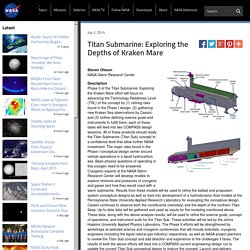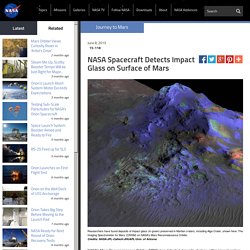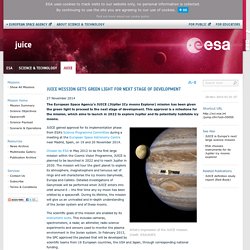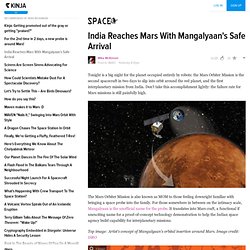

We Finally Know What Happened to Water on Mars. Liquid Water on Mars. Nasa scientists find evidence of flowing water on Mars. Here Are All the Best Photos from India's Mars Mission. Scientists Discover Weather on Rosetta's Comet. Something Bizarre Is Happening On the Surface of Rosetta's Comet. New Horizons Restarts Sending Pretty, Pretty Data Home Today! India's Mars Orbiter just sent in these photos . : space. Why Pluto Lacks Craters, and Why That's So Freakishly Weird. Here's What We Just Learned About Pluto. We're scientists on the NASA New Horizons team, which is at Pluto. Ask us anything about the mission & Pluto! : IAmA. Pluto Is a Geologically Active World, But We Don't Know Why.
How to Get to Pluto: From a Waterpark. Titan Submarine: Exploring the Depths of Kraken Mare. Steven Oleson NASA Glenn Research Center Description Phase II of the Titan Submarine: Exploring the Kraken Mare effort will focus on advancing the Technology Readiness Level (TRL) of the concept by (1) retiring risks found in the Phase I design, (2) gathering new Kraken Sea observations by Cassini, and (3) further defining science goals and instruments to fulfill them; each of these tasks will feed into two COMPASS design sessions.

All of these products should ready the Titan Submarine (Titan Sub) concept to a confidence level that allow further NASA investment. The major risks found in the Phase I conceptual design center around vehicle operations in a liquid hydrocarbon sea. Basic physics questions of operating in this cryogen need to be answered. Cryogenic experts at the NASA Glenn Research Center will develop models to explore mixtures and pressures of cryogens and gases and how they would react with a warm submarine. 7 Innovative Concepts are Getting Closer to Reality Thanks to NASA. NASA Spacecraft Detects Impact Glass on Surface of Mars. HOUSTON - After an extensive year-and-a-half search, NASA has a new group of potential astronauts who will help the agency push the boundaries of exploration and travel to new destinations in the solar system, including an asteroid and Mars.

15 Projects NASA Wants To Change From Science Fiction To Science Fact. Everything We've Learned from 50 Years of (Deliberate) Spaceship Crashes. Curiosity. All the Robotic Space Explorers since 1958. Kinja is in read-only mode.

We are working to restore service. Why do they show the Pioneers and Voyagers as looping around the planets? Didn't they just skim them? Except for the ones that actually went into orbit around Jupiter and Saturn (i.e. Galileo and Cassini), all the others just bent their trajectories a little bit. Flagged. This Is Every Place In The Solar System Ever Occupied Entirely By Robots. An Unexpected Discovery On The Surface Of Rosetta's Comet. Venus Express Is Dead, Leaving The Planet Without Robot Explorers. So where's the hi-def footage of Venus from up close?

How cool would it be to see the video of its final descent into the atmosphere, heading for the surface? Is it just me, or does NASA miss an awful lot of opportunities to show the world awesome stuff like this? Oh I'm sure we "got the data" and all, but imagine how inspired people would be to see something like that. Flagged This particular mission is actually ESA, not NASA. ;) The satellite is spinning out of control, with the antenna pointing all over the place and just occasional brief moments of communication with us here on Earth.
[!] xkcd 1446. Touchdown! Rosetta’s Philae probe lands on comet / Rosetta. Farewell Philae - narrow-angle view Touchdown!

Rosetta’s Philae probe lands on comet 12 November 2014 ESA’s Rosetta mission has soft-landed its Philae probe on a comet, the first time in history that such an extraordinary feat has been achieved. JUICE mission gets green light for next stage of development. 27 November 2014 The European Space Agency's JUICE (JUpiter ICy moons Explorer) mission has been given the green light to proceed to the next stage of development.

This approval is a milestone for the mission, which aims to launch in 2022 to explore Jupiter and its potentially habitable icy moons. JUICE gained approval for its implementation phase from ESA’s Science Programme Committee during a meeting at the European Space Astronomy Centre near Madrid, Spain, on 19 and 20 November 2014. A Change In Congress Has Increased The Chances Of A Europa Mission. I really like the fact that he's supporting a mission to Europa.

I just wish he weren't so insistent that we will find life if we go there. Such a statement might help to get the mission funded, but if we don't find anything there, or we only find microbial life, the general public probably won't be so willing to support future mission. Most people don't understand the importance of knowledge for knowledge's sake. For example, I've had to explain to several people that despite the short lifespan of the Philae lander, it was still an amazing accomplishment, and is going to provide an enormous amount of new data that could eventually lead to new technologies and techniques that may, in turn, lead to even more. Most people stop listening when they hear that the mission wasn't perfect, and conclude that it was a waste. Lots of very vocal, very dedicated voters are already inherently distrustful of science.
Flagged. Ancient Mars May Have Been More Habitable Than We Thought. Kinja is in read-only mode.

We are working to restore service. And unfortunately has no magnetic field. Flagged a little earlier? Mars Rover Curiosity Drills into Mount Sharp. In its continuing mission to fathom whether Mars’ ancient environment may have been suitable to host microbial life, NASA’s Mars rover Curiosity once again dusted off its drill piece and, for the first time, bored into a rock at the base of Mount Sharp — a 3.5 mile high mountain in the center of Gale Crater also known as Aeolis Mons.

PHOTOS: Curiosity Snaps Selfies, Begins Mars Rock Drill Curiosity is currently located at the “Pahrump Hills” outcrop at the mountain’s base and mission scientists are excited by this new phase of the mission as samples collected from Mount Sharp will also help us understand how the mountain formed. “This drilling target is at the lowest part of the base layer of the mountain, and from here we plan to examine the higher, younger layers exposed in the nearby hills,” said Curiosity Deputy Project Scientist Ashwin Vasavada of NASA’s Jet Propulsion Laboratory in Pasadena, Calif. NEWS: Curiosity Does Drilling U-Turn on Wobbly Mars Rock.
India Reaches Mars With Mangalyaan's Safe Arrival. India managed a successful mission with only $74 million, a delightfully low pricetag that came with a few hard constraints For comparison.

I really appreciate cinematography, but can't help but think there is something wrong with the priorities somewhere. The Landing Site On Comet Churymov-Gerasimenko Has Been Selected. Gif of the Rosetta flight path from launch to landing on the comet : space. Lunar Mission Timeline. The Curiosity Rover Has Arrived At Its Primary Scientific Target! NASA's Planned Missions. Keeping in Touch with Our Space Explorers. NASA wants to send a quadcopter to Saturn’s giant moon Titan. Saturn’s largest moon Titan fascinates the scientists at NASA due to its dense atmosphere and the presence of stable bodies of surface liquid alongside ice and rock.
The nitrogen rich atmosphere experiences wind and rain, meaning the mix has produced a moon with similar features to Earth’s own surface, complete with rivers, lakes and seas (of liquid methane or ethane), mountains, and dunes. Such an interesting place deserves to be explored, but visiting Titan for an extended period of time hasn’t been feasible due to a lack of supporting technology.
NASA’s ideal vehicle for exploration there would be a helicopter, able to move quickly from place-to-place taking photos and collecting samples. But such a craft would be too expensive to develop and deploy, we haven’t had the tech to make it work autonomously, and even then you wouldn’t be able to support it.
Other missions including a balloon, plane, and boat have also been proposed and later shelved. NASA Has Recovered 7 "Precious" Particles From The Solar System's Birth. Seven precious particles, you say? SExpand Did they, by any chance, originate from here: Because if so, someone wants them back: New Tool Coming In Hunt For Alien Life. With the James Webb Space Telescope still more than four years away from launch astronomers are coming up with ideas on how to maximise its usefulness.
A proposal published in Astrobiology outlines a way it could be used to detect signatures of life on planets around nearby stars. While it is always possible that life around extrasolar worlds will be “not as we know it”, the obvious place to start looking is on planets as similar as possible to our own. This includes the presence of liquid water, which in turn requires a substantial atmosphere. Low atmospheric pressure means water boils as soon as it melts. Mars Reconnaissance Orbiter: Overview. NASA's Mars Reconnaissance Orbiter blasted off from Cape Canaveral in 2005, on a search for evidence that water persisted on the surface of Mars for a long period of time.
While other Mars missions have shown that water flowed across the surface in Mars' history, it remains a mystery whether water was ever around long enough to provide a habitat for life. Mars Reconnaissance Orbiter is studying the history of water on Mars After a seven-month cruise to Mars and six months of aerobraking to reach its science orbit, Mars Reconnaissance Orbiter began seeking out the history of water on Mars with its science instruments.
The instruments zoom in for extreme close-up photography of the martian surface, analyze minerals, look for subsurface water, trace how much dust and water are distributed in the atmosphere, and monitor daily global weather. After 100 days of science, LADEE will smash into the Moon. Jade Rabbit wakes up from lunar sleep. China's first lunar rover, Jade Rabbit, has woken up after a two-week shutdown, but problems remain to get the probe fully operational. China's Jade Rabbit Moon Rover Has Been Lost. The most important alarm in the solar system is set to go off tomorrow. This mysterious rock just appeared in front of our rover on Mars. This spidery spacecraft will be the first to soft-land on a comet. NASA snaps a pic of China's Yutu Rover from 93 miles overhead. This Jumble of Tent Poles Could Be NASA's Next Titan-exploring Robot. Here's what China's Yutu rover is doing on the Moon.
The moments as the lunar rover Yutu separated from the lander. First Images From Chang’E 2 Released. Index.php (400×266) The Overprotection of Mars? A recent commentary paper published in the journal Nature Geoscience argues that planetary protection policies and practices designed to guard solar system bodies from biological contamination from spacecraft need to be re-evaluated because they are “unnecessarily inhibiting” a more ambitious agenda to search for life on Mars.
In the paper, called The Overprotection of Mars, co-authors Alberto G. Fairén of the Department of Astronomy, Cornell University and Dirk Schulze-Makuch of the School of the Environment, Washington State University, also argue that, from an astrobiological perspective, the most interesting missions to “Special Regions” - where, in theory, Mars life could exist or Earth life could survive - are rendered “unviable” as a result of onerous Committee on Space Research (COSPAR) planetary protection protocols and the need to comply with “detailed and expensive sterilization requirements.” A Bug in the Program "This has happened in all Mars missions. Mission to Mars: MAVEN to Explore the Red Planet’s Atmosphere. India Successfully Launches First Mission To Mars. Japanese scientists successfully test asteroid-blasting space cannon. Wait Calculation. JBIS: Interstellar Travel - The Wait Calculation and the Incentive Trap of Progress. Enlightening stuff. Neat Stuff Ecstasy Drug-Crazed Ravers Are Like Chemical Buddhas Published on April 4th, 2014 | by Jason Louv Ecstasy drug-fueled Dutch ravers are by turns idiotic and profound in this hilarious video This video (via the Dutch magazine Flabber) captures partygoers out of their skulls on Ecstasy at Thunderdome, a hardcore techno / gabber festival that [&hellip...
Read More → Voyager, The Love Story. Voyager, The Love Story April 28, 2011: One day, perhaps billions of years from now, aliens might be surprised to run across an old spaceship from Earth. Far from home, the ancient probe is cold, its nuclear power source spent long ago; an iconic white antenna points silently into the void, beaming no data to the species that made it.